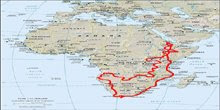We arrived at noon and drove along the Galana River for a few hours, and even though it was midday we saw waterbuck by the dozen, elephant, impala, dik-diks, hippos, zebra, crocodiles, a Goliath Heron and an Egyptian Vulture. We stopped for a picnic of bread, cheese and tomatoes next to the river, being careful that there were no crocs, hippos or lions near us. We had been out of the car a few minutes when we heard a rumbling sound and saw dust rising about one hundred metres away… buffalo! Fortunately they were actually running away from us, and not towards us.

40km of uneventful tracks took us south of the river to the Aruba dam where we soon spotted a lioness under a tree. As far as we know it could have been a lion. We are not sure because the male Tsavo lions do not have manes. It is said that their higher than average testosterone level causes them to be less hairy. It also makes them more aggressive than average, and the story “the man-eaters of Tsavo” known from the movie “Ghosts in the Darkness” illustrates the point. It tells of 2 lions that ate their way through 147 workers of the Ugandan railway at the beginning of the 20th century!
Of course, we stopped the engine to look at our lion at leisure. When she stood up for a stroll, we tried to start the car again to follow her…but the car wouldn’t start! Oh oh… it has happened before: the immobiliser. Simple enough to fix, but in order to do so Steve has to get out to open the bonnet and disconnect the battery. With the lion less than 20 meters away it is out of question….
After sometime the lion walked a bit further away. Then two safari vehicles arrived from a nearby lodge. They were too busy watching the lion to imagine our situation and the lion busy watching them. Steve decided to get out of the car (with Caro keeping a worried watch over the landscape of tall yellow grasses) and fixed the car!
Quite an adrenaline rush!
The rest of the day was more peaceful, with the highlight being the sight of hundreds of red elephants and buffalo on the Kwanderi swamps and a giraffe scratching its ear.
 Rush hour in Tsavo National Park
Rush hour in Tsavo National ParkVIDEO of the giraffe scratching its ear
PHOTO of Steve removing the immobiliser in Nairobi.

 The small but busy harbour at Mokowe
The small but busy harbour at Mokowe Lamu's main square
Lamu's main square  View of the main square from the fort
View of the main square from the fort  The fort's entrance
The fort's entrance
 Lamu's streets
Lamu's streets Shella beach
Shella beach Caro's new clothes - the bui-bui
Caro's new clothes - the bui-bui General view of the main road
General view of the main road  Detail of the main road
Detail of the main road  Dodgy bridges (Caro scouting one of them)
Dodgy bridges (Caro scouting one of them)  Curious villagers (Scarlet is an attraction)
Curious villagers (Scarlet is an attraction)  Warning: elephants crossing
Warning: elephants crossing  Cooking in the bush
Cooking in the bush



 Images from the high plateaux
Images from the high plateaux




